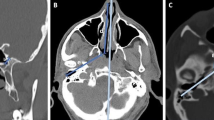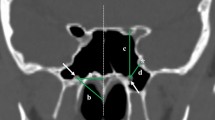Abstract
Introduction
The endoscopic endonasal approach (EEA) provides visualization of four deep surgical corridors (transcribiform, transtubercular, transsellar, and transclival) with superior illumination and specialized deep-reaching instruments, as compared to microscopic techniques. Several studies have evaluated EEAs in children but do not stratify for the very young of age, whose particularly small nares and developmental anatomy may limit endonasal instrumentation.
Methodology
A comprehensive review of EEAs in infants and children to age 4 was performed to determine the limitations in this age group.
Results
Eighteen studies were identified describing this approach for pediatric patients and the surgical caveats and limitations were reviewed. In very small children, CSF leaks, meningioencephaloceles, tumors of the anterior skull base, and lesions at the rostral cervical spine have been successfully treated endonasally. While newer studies advocate using 2.7-mm diameter (18-cm length) lenses, 4-mm diameter rigid lenses have been used without technical difficulty. The youngest patient in whom an EEA was used was a 6-week-old for a dermoid resection. Some have advocated that due to the small nares, approaches via bilateral entry are optimal for multiple instruments, however, others, including authors of a series of 28 repaired CSF leaks demonstrate successful single nare access.
Discussion
EEAs are associated with less blood loss, are less likely to hinder normal growth of the skull and midface, and allow for the resection of even malignant lesions. Despite the limitations of the frontal, ethmoid, and sphenoid sinuses before age 3, reports have not documented insurmountable difficulty with EEAs even in infants. 2.7-mm diameter endoscopes are favored unilaterally or bilaterally to treat both benign and malignant lesions and preserve the young patient’s facial anatomy better than older methods. Ever improving technology has facilitated the use of this approach in patients it would otherwise be infeasible for in the past, but it still cannot overcome the anatomical constraints of certain young patients in which this approach remains unindicated. Patient selection is therefore of utmost importance and the risks and benefits of more extensive approaches in these cases must be considered.







Similar content being viewed by others
References
Banu MA, Guerrero-Maldonado A, McCrea HJ, Garcia-Navarro V, Souweidane MM, Anand VK et al (2014) Impact of skull base development on endonasal endoscopic surgical corridors. J Neurosurg Pediatr. 13(2):155–169
Chen G, Zhang Q, Ling F (2011) An endoscopic endonasal approach for the surgical repair of transsphenoidal cephalocele in children. J Clin Neurosci 18(5):723–724
Chivukula S, Koutourousiou M, Snyderman CH, Fernandez-Miranda JC, Gardner PA, Tyler-Kabara EC (2013) Endoscopic endonasal skull base surgery in the pediatric population. J Neurosurg Pediatr. 11(3):227–241
Di Rocco F, Couloigner V, Dastoli P, Sainte-Rose C, Zerah M, Roger G (2010) Treatment of anterior skull base defects by a transnasal endoscopic approach in children. J Neurosurg Pediatr 6(5):459–463
Emanuelli E, Bossolesi P, Borsetto D, D'Avella E (2014) Endoscopic repair of cerebrospinal fluid leak in paediatric patients. Int J Pediatr Otorhinolaryngol 78(11):1898–1902
Hickman ZL, MM MD, Barton SM, Sussman ES, Grunstein E, Anderson RC (2013) Transnasal endoscopic approach to the pediatric craniovertebral junction and rostral cervical spine: case series and literature review. Neurosurg Focus 35(2):E14
Holzmann D, Bsozinov O, Krayenbühl N (2014) Is there a place for the endoscope in skull base surgery in children less than 5 years? J Neurol Surg A Cent Eur Neurosurg 75(2):133–139
Kassam A, Thomas AJ, Snyderman C, Carrau R, Gardner P, Mintz A et al (2007) Fully endoscopic expanded endonasal approach treating skull base lesions in pediatric patients. J Neurosurg 106(2 Suppl):75–86
Lepera D, Volpi L, De Bernardi F, Shawkat SA, Cimetti L, Bignami M et al (2015) Endoscopic transnasal resection of Eustachian-tube dermoid in a new-born infant. Auris Nasus Larynx 42(3):235–240
Liu JK, Patel J, Goldstein IM, Eloy JA (2015) Endoscopic endonasal transclival transodontoid approach for ventral decompression of the craniovertebral junction: operative technique and nuances. Neurosurg Focus 38(4):E17
Locatelli D, Castelnuovo P, Santi L, Cerniglia M, Maghnie M, Infuso L (2000) Endoscopic approaches to the cranial base perspectives and realities. Childs Nerv Syst 16(10–11):686–691
Ma J, Huang Q, Li X, Huang D, Xian J, Cui S et al (2015) Endoscopic transnasal repair of cerebrospinal fluid leaks with and without an encephalocele in pediatric patients: from infants to children. Childs Nerv Syst 31(9):1493–1498
Patel AJ, Boatey J, Muns J, Bollo RJ, Whitehead WE, Giannoni CM et al (2012) endoscopic endonasal odontoidectomy in a child with chronic type 3 atlantoaxial rotatory fixation: case report and literature review. Childs Nerv Syst 28(11):1971–1975
Rastatter JC, Snyderman CH, Gardner PA, Alden TD, Tyler-Kabara E (2015) Endoscopic endonasal surgery for sinonasal and skull base lesions in the pediatric population. Otolaryngol Clin N Am 48(1):79–99
Re M, Tarchini P, Macrì G, Pasquini E (2012) Endonasal endoscopic approach for intracranial nasal dermoid sinus cysts in children. Int J Pediatr Otorhinolaryngol 76(8):1217–1222
Tan SH, Mun KS, Chandran PA, Manuel AM, Prepageran N, Waran V et al (2015) Combined transnasal and transoral endoscopic approach to a transsphenoidal encephalocele in an infant. Childs Nerv Syst 31(7):1165–1169
Taşkapılıoğlu MÖ, Yilmazlar S, Eren E, Tarım O, Güler TM (2015) Transnasal transsphenoidal surgical method in pediatric pituitary adenomas. Pediatr Neurosurg 50(3):128–132
Tatreau JR, Patel MR, Shah RN, McKinney KA, Wheless SA, Senior BA, Ewend MG, Germanwala AV, Ebert CS Jr, Zanation AM (2010) Anatomical considerations for endoscopic endonasal skull base surgery in pediatric patients. Laryngoscope. 120(9):1730–1737
Author information
Authors and Affiliations
Contributions
Andrew Kobets, Adam Ammar, and Kamilah Dowling participated in the literature review and preparation of the manuscript. James Goodrich and Andrew Kobets formulated the concept for this work. Alan Cohen, James Goodrich, and Andrew Kobets were involved in the revision and critical review of the iterations of the manuscript.
Corresponding author
Ethics declarations
Conflict of interest
The authors declare that they have no conflicts of interest.
Ethical approval
All procedures performed in studies were in accordance with the ethical standards of the Albert Einstein College of Medicine Institutional Review Board.
Additional information
Publisher’s note
Springer Nature remains neutral with regard to jurisdictional claims in published maps and institutional affiliations.
Rights and permissions
About this article
Cite this article
Kobets, A., Ammar, A., Dowling, K. et al. The limits of endoscopic endonasal approaches in young children: a review. Childs Nerv Syst 36, 263–271 (2020). https://doi.org/10.1007/s00381-019-04455-y
Received:
Accepted:
Published:
Issue Date:
DOI: https://doi.org/10.1007/s00381-019-04455-y




